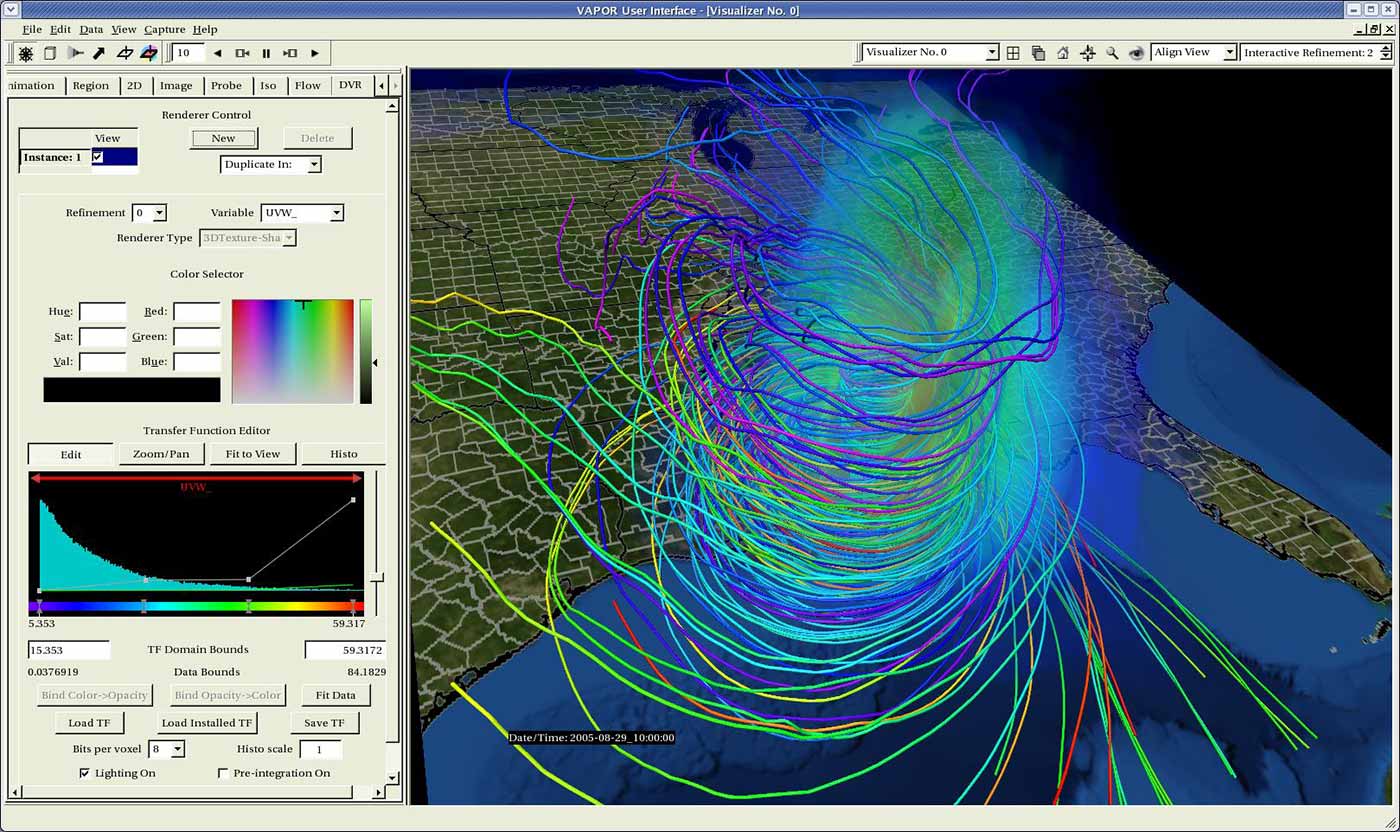
NSF Grant to Improve Visualization Capabilities for the Biosciences and Geosciences
Published Date
By:
- David Hosansky and Marikje Unger
Share This:
Article Content

Weather simulation/Photo: courtesy of John Clyne, National Center for Atmospheric Research
The National Center for Atmospheric Research (NCAR) is partnering with the University of California, San Diego (UC San Diego), to expand and enhance visualization capabilities in the bio- and geosciences through a grant from the National Science Foundation.
The collaboration builds on existing software capabilities developed at NCAR and UC San Diego, and it will combine them to produce new open source tools for scientists to explore large data sets.
The project is known as WASP (Wavelet-enabled Progressive Data Access and Storage Protocol).
Current advances in digital imaging and numerical modeling technologies have enabled the creation of vast amounts of data. A challenge for many researchers is making sense out of these digital outputs. One way of dealing with extremely large data sets is known as progressive data access (PDA), which is the enabling technology behind consumer applications like Google Maps. In mapping applications, PDA reduces data volumes by only loading areas of interest, not the entirety of the map database, and allows the user to view these images in greater detail or lesser detail.

CT scan of a sea dragon./Photo: courtesy of Prof. Robert Sah/UC San Diego.
The problem is that similar tools are scarce in the biosciences, despite a need for analyzing data gathered from advanced imaging technologies such as MRI and CT scans. And as the size and complexity of the data increase, the computing resources commonly available for data analysis are over-subscribed. The geosciences encounter similar issues, with models for weather, climate, oceans and other Earth systems generating very large and complex data.
Given the similar nature of the challenge across various disciplines, researchers at NCAR and UC San Diego put their heads together to work on a solution, capitalizing on complementary work that was already ongoing at both institutions. Though the bio- and geosciences are very different scientific disciplines, with different data, the underlying forms of the data and structure of the data are very similar, allowing for shared methods of dealing with the data.
Two software approaches
An NCAR team has developed a software solution known as VAPOR, (Visualization and Analysis Platform for Ocean, Atmosphere and Solar Researchers). VAPOR provides an interactive 3D visualization environment that runs on most UNIX and Windows systems. At the heart of VAPOR is a progressive data access scheme based on mathematical linear transforms using wavelets. An NSF grant launched the development of the technology in 2003, and VAPOR is currently on its third major release, with over 6,000 users worldwide.
“VAPOR is an application specifically designed to facilitate researchers’ interaction with very large data sets, but while using only relatively modest computing resources,” said John Clyne, a software engineer and computer scientist who is the principal investigator for VAPOR in NCAR’s Computational and Information Systems Laboratory (CISL). “It is already widely used in the geosciences community, and with this award we will not only be able to expand and improve it for its current users, but also make it usable for the biosciences and bioimaging communities.”
At UC San Diego, the Center for Scientific Computation in Imaging has been developing a general analysis and visualization software toolkit for the bioimaging community, known as the Shape Analysis for Phenomics from 3D Imaging Data (SAPID) ToolKit (STK).
The goal of the SAPID project is to develop advanced computational methods for researchers in evolutionary biology to characterize subtle morphological variations from high-resolution 3D voxel-based digital imaging modalities. A critical issue that arose in this project was the necessity of being able to handle very large datasets. This new NSF award will address this important issue and thus provide these innovative capabilities to the bio-imaging community.
“This award is exciting because it allows us to take our existing software, combine and reuse it in new ways, and expand its capabilities to serve more broadly across scientific disciplines,” said UC San Diego’s Lawrence Frank, the principal investigator for the WASP award and the SAPID Project, as well as a researcher at the Institute of Engineering in Medicine.
Both Frank and Clyne point out that the most important aspect of this collaboration is that it will reuse existing NSF-funded software to provide a common framework that benefits both biological digital imaging and geosciences numerical modeling communities, and will have a profound impact for scientists working with large data sets.
“We’ll be able to provide better tools to the climate and weather science communities, while providing the first such tools for the biosciences community,” said Clyne. “It’s especially gratifying that NSF’s initial investments in both VAPOR and STK can be augmented with this award to produce an impactful and inter-disciplinary tool.”
The University Corporation for Atmospheric Research manages the National Center for Atmospheric Research under sponsorship by the National Science Foundation. Any opinions, findings and conclusions, or recommendations expressed in this publication are those of the author(s) and do not necessarily reflect the views of the National Science Foundation.
Share This:
You May Also Like
Stay in the Know
Keep up with all the latest from UC San Diego. Subscribe to the newsletter today.


